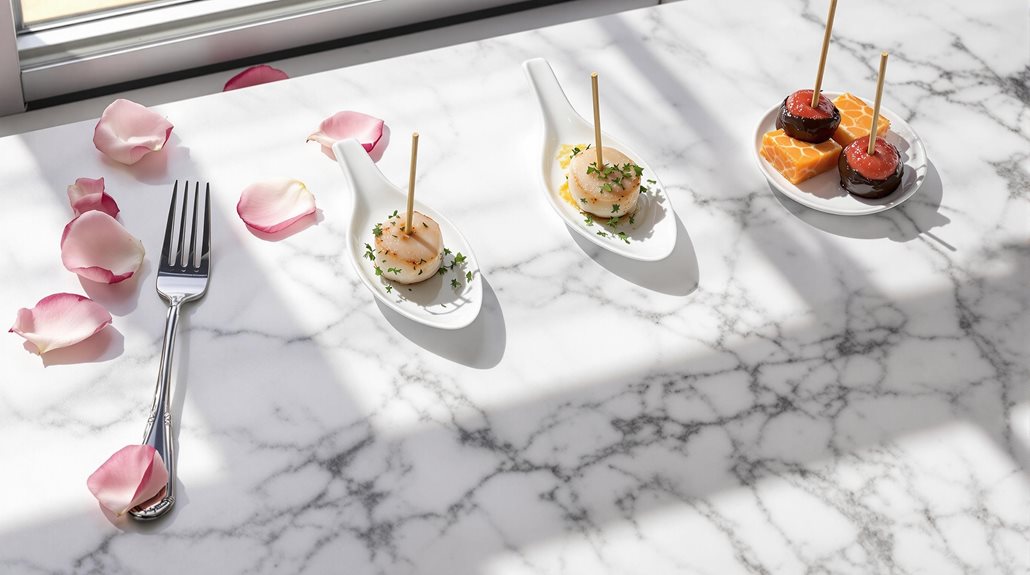
Wedding Menu Planning Guide: Options & Costs
Share
Planning your wedding menu requires balancing service style, budget, and guest experience. You'll need to decide between plated dinners (around £20.70 per person), buffets, family-style service, or food stations - each offering distinct advantages for your reception.
Expect to allocate about 28% of your wedding budget to catering expenses while considering dietary restrictions and seasonal ingredients. Start your menu planning 9-12 months before the wedding, scheduling tastings and finalising details 6-9 months out.
Understanding these key elements will help you create a memorable dining experience that reflects your style and satisfies your guests.
Key Takeaways
- Based on your budget and guest preferences, you can choose between plated dinners ($26/person), buffet service, family-style, or food stations.
- Allocate approximately 28% of your wedding budget for catering expenses and consider seasonal ingredients to reduce costs.
- Begin menu planning 9-12 months before the wedding, schedule tastings, and finalise selections 6-9 months prior.
- Collect dietary restrictions during RSVPs and ensure the menu accommodates common needs, such as vegetarian, vegan, and gluten-free options.
- Compare caterers using a detailed spreadsheet, considering in-house kitchen availability, staff requirements, and overall service costs.
Understanding Your Wedding Menu Options
Choosing a wedding menu style sets the tone for your entire reception and influences how your guests will experience the celebration. You must choose between two primary serving styles: the traditional plated sit-down dinner or the more versatile buffet. Each style offers distinct advantages that can complement your wedding vision.
A plated sit-down dinner delivers an elevated dining experience with three carefully orchestrated courses. This format provides structure and elegance, making it perfect if you envision a formal atmosphere where guests can enjoy their meals leisurely. The average plated cost is £20.70 per person, making it a more economical choice than buffet service. The strategic meal timing throughout your reception can greatly impact guest satisfaction and overall event flow.
The buffet style opens up creative possibilities while offering greater flexibility for dietary preferences. You can explore various themes, from international cuisine that showcases your favourite global dishes to farm-to-table options featuring local specialities. Buffets also incorporate gourmet comfort foods or create dedicated stations for vegetarian, vegan, or seafood selections.
When planning your menu, consider your guests' dietary requirements and potential allergies. Work closely with your caterer to ensure you accommodate various needs while maintaining the integrity of your vision.
Consider requesting an allergens chart to display during the reception, giving guests peace of mind about their food choices. Don't forget to align your beverage selections with your menu, whether offering signature cocktails or an array of non-alcoholic options to complement your chosen dishes.
Smart Budgeting for Wedding Food
This is a crucial aspect of your wedding planning, as wedding food costs typically consume the largest portion of your reception budget. Smart financial planning is essential for this crucial element.
Wedding food costs typically consume the largest portion of your reception budget, making smart financial planning essential for this crucial element.
The most significant cost-saving strategies begin with your guest list—reducing the number of attendees directly impacts your catering expenses, along with related costs like decor, rentals, and favours. Careful planning is essential because catering typically takes up 28% of the wedding budget. Consider creating an A and B list to manage invitations within your budget constraints, ideally keeping your count to 50 or fewer guests.
Your menu choices present numerous opportunities for savings without sacrificing quality. Opt for budget-friendly ingredients by selecting seasonal and local foods, which often taste better and cost less than out-of-season alternatives. Scheduling your wedding during off-peak seasons can lead to significant discounts from catering vendors.
Consider incorporating vegetarian or vegan options and choosing affordable proteins like chicken or salmon instead of premium meats. The service style you select also impacts costs significantly— it requires fewer staff than plated meals, while family-style service offers a middle-ground solution.
When selecting your venue, prioritise locations with in-house kitchens to reduce equipment and setup expenses. You'll want to review kitchen facilities before booking to ensure they meet your catering needs.
Work closely with your caterer to develop a menu that aligns with your budget while maintaining quality. Focus on simple, well-executed dishes rather than elaborate presentations, and consider limiting the number of courses.
Food trucks can provide an economical alternative to traditional catering services for smaller celebrations or weekday weddings.
Choosing Your Service Style
Now that you've established your budget parameters, your selected service style will shape your guests' dining experience and significantly impact your overall reception atmosphere. Each style offers distinct advantages that can align with your vision and practical needs.
Plated advantages include a sophisticated presentation and precise portion control. Your guests won't need to leave their seats; you'll know exactly how much food you order. Guests must pre-select their entrees when sending their RSVPs to ensure satisfaction. The elegant waitstaff service adds a refined touch to your celebration. However, you'll need accurate RSVPs and typically face higher labour costs for the dedicated wait staff required to serve each course.
Buffet flexibility makes it an attractive option for hosting a larger wedding or offering more menu variety. Your guests can choose their portions and selections, though you'll need to manage traffic flow and ensure food stays at proper temperatures. While it encourages mingling, some guests might find waiting in line less appealing.
Family intimacy shines through when dishes are served directly to each table. This style creates a warm, communal atmosphere as guests pass platters and interact naturally. While it requires attentive staff to maintain tidiness, it's adaptable to various group sizes and cost-effective with proper planning.
Food stations offer an engaging experience where guests can explore cuisines and interact with chefs. This modern approach works well for varied dietary needs and creates natural conversation points throughout your reception space. You'll need careful coordination to maintain food quality and prevent bottlenecks at popular stations.
Menu Planning Timeline
Organisation is crucial when planning your wedding menu, and following a structured timeline ensures you'll hit every important milestone. Your menu planning journey begins 9-12 months before your wedding when you'll research caterers and explore current catering trends. Breaking down tasks helps make the planning process more manageable.
During this pre-planning phase, you'll want to create a detailed spreadsheet comparing potential vendors while considering your budget and guests' dietary needs. Due to high demand, you may need to book over a year in advance for holiday season weddings.
- Discuss menu options that align with your wedding date to take advantage of seasonal ingredients. This can save money and ensure the freshest flavours.
- Schedule multiple tastings with caterers to compare their culinary styles and presentation techniques.
- Consider how your menu choices complement your wedding theme and venue setting.
Six to nine months before your big day, you'll select your final caterer and menu through tasting sessions. This is when you'll make crucial decisions about appetisers, main courses, and desserts while accommodating all dietary restrictions.
You'll focus on logistics between three and six months out, providing estimated guest counts and discussing setup details with your chosen vendor.
The final stretch, occurring one to three months before your wedding, is all about confirming the details. You'll provide your final guest count, review the seating arrangement with your caterer, and ensure all payment arrangements are in place.
Don't forget to confirm arrival and teardown times, as these logistics are essential for a smooth reception flow.
Tips for Menu Success
Success in wedding menu planning hinges on thoughtful contemplation of your guests' needs, budget constraints, and culinary preferences.
You'll need to balance creating an impressive culinary experience, maintaining financial responsibility, and ensuring dietary inclusivity for all your guests. To make the menu more meaningful, consider adding signature dishes that tell your love story. Creating elegant displays of your menu selections enhances the overall dining experience and adds to the celebratory atmosphere.
Start by determining your per-person budget and selecting a service style that aligns with your vision. If you're working with a tighter budget, deliberate a buffet-style service, which often costs less than a plated dinner while offering greater variety.
For a more upscale experience, food stations can provide an interactive dining experience that showcases seasonal flavours and specialities.
Gather dietary restriction information during the RSVP process. You'll want to accommodate common requirements like vegetarian, vegan, and gluten-free options and any religious nutritional needs.
Please work with your caterer to create clear menu labels identifying allergens and ingredients, helping guests navigate their choices confidently.
Schedule a tasting session with your caterer to sample potential dishes and discuss how to incorporate seasonal ingredients. This is your opportunity to refine flavour combinations and ensure everything meets your standards.
Remember to deliberate how your beverage selections will complement the menu—thoughtful wine pairings can elevate the entire dining experience.
Finally, think about timing and presentation. Your menu should reflect the time of day of your reception, and you'll want to discuss with your caterer how to display and serve each course best to maintain food quality and temperature throughout the event.
Conclusion
As you've journeyed through this wedding menu planning guide, you're now equipped like a master chef to create your perfect culinary celebration.
From budgeting like a seasoned accountant to timing each decision with military precision, you have the ingredients for success. Remember, your menu isn't just about food—it's about crafting memories that'll have guests talking long after the last champagne toast.
